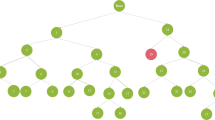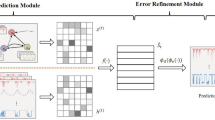Abstract
Condition monitoring systems are widely used to monitor the working condition of equipment, generating a vast amount and variety of monitoring data in the process. The main task of surveillance focuses on detecting anomalies in these routinely collected monitoring data, intended to help detect possible faults in the equipment. However, with the rapid increase in the volume of monitoring data, it is a nontrivial task to scan all the monitoring data to detect anomalies. In this paper, we propose an approach called latent correlation-based anomaly detection (LCAD) that efficiently and effectively detects potential anomalies from a large number of correlative isomerous monitoring data series. Instead of focusing on one or more isomorphic monitoring data series, LCAD identifies anomalies by modeling the latent correlation among multiple correlative isomerous monitoring data series, using a probabilistic distribution model called the latent correlation probabilistic model, which helps to detect anomalies according to their relations with the model. Experimental results on real-world data sets show that when dealing with a large number of correlative isomerous monitoring data series, LCAD yields better performances than existing anomaly detection approaches.

















Similar content being viewed by others
Notes
The response time delay is a physical property, determined by the manufacturing of the equipment. The response time delay can be shortened by improving the manufacturing, which is beyond the scope of this paper. In this paper, we make the reasonable assumption that most sensors of the same type have the same response time.
References
Aggarwal CC, Philip SY (2008) Outlier detection with uncertain data. In: SDM. SIAM, pp 483–493
Atzori L, Iera A, Morabito G (2010) The internet of things: A survey. Comput Netw 54(15):2787–2805
Bilmes JA, et al. (1998) A gentle tutorial of the em algorithm and its application to parameter estimation for gaussian mixture and hidden markov models. Int Comput Sci Inst 4(510):126
Chan PK, Mahoney MV (2005) Modeling multiple time series for anomaly detection. In: Data Mining, Fifth IEEE International Conference on, pages 8–pp. IEEE
Das K, Schneider J (2007) Detecting anomalous records in categorical datasets. In: Proceedings of the 13th ACM SIGKDD international conference on Knowledge discovery and data mining, pp 220–229. ACM
Dutton WH (2013) The internet of things. Available at SSRN
Fawcett T (2006) An introduction to roc analysis. Pattern Recogn Lett 27(8):861–874
Fujimaki R, Nakata T, Tsukahara H, Sato A, Yamanishi K (2009) Mining abnormal patterns from heterogeneous time-series with irrelevant features for fault event detection. Stat Anal Data Min 2(1):1–17
Ghoting A, Parthasarathy S, Otey ME (2008) Fast mining of distance-based outliers in high-dimensional datasets. Data Min Knowl Disc 16(3):349–364
Heard NA, Weston DJ, Platanioti K, Hand DJ, et al. (2010) Bayesian anomaly detection methods for social networks. Ann Appl Stat 4(2):645–662
Hecht-Nielsen R (1989) Theory of the backpropagation neural network. In: Neural Networks, 1989. IJCNN., International Joint Conference on, pp 593–605. IEEE
Hu X, Hu S, Zhang X, Zhang H, Luo L (2014) Anomaly detection based on local nearest neighbor distance descriptor in crowded scenes. Sci World J:2014
Izakian H, Pedrycz W (2013) Anomaly detection in time series data using a fuzzy c-means clustering. In: IFSA World Congress and NAFIPS Annual Meeting (IFSA/NAFIPS), 2013 Joint, pp 1513–1518. IEEE
Janakiram D, Adi Mallikarjuna Reddy V, Phani Kumar AVU (2006) Outlier detection in wireless sensor networks using bayesian belief networks. In: Communication System Software and Middleware, 2006. Comsware 2006. First International Conference on, pp 1–6. IEEE
Keogh E, Chakrabarti K, Pazzani M, Mehrotra S (2001) Locally adaptive dimensionality reduction for indexing large time series databases. ACM SIGMOD Rec 30(2):151–162
Keogh E, Kasetty S (2003) On the need for time series data mining benchmarks: a survey and empirical demonstration. Data Min Knowl Disc 7(4):349–371
Kou Y, Lu C-T, Chen D (2006) Spatial weighted outlier detection. In: SDM, pp 614–618. SIAM
Liu D, Lung C-H, Lambadaris I, Seddigh N (2013) Network traffic anomaly detection using clustering techniques and performance comparison. In: Electrical and Computer Engineering (CCECE), 2013 26th Annual IEEE Canadian Conference on, pp 1–4. IEEE
Ma J, Perkins S (2003) Online novelty detection on temporal sequences. In: Proceedings of the ninth ACM SIGKDD international conference on Knowledge discovery and data mining, pp 613–618. ACM
Mabu S, Chen C, Lu N, Shimada K, Hirasawa K (2011) An intrusion-detection model based on fuzzy class-association-rule mining using genetic network programming. IEEE Trans Syst Man Cybern Part C Appl Rev 41(1):130–139
Mahoney MV, Chan PK (2002) Learning nonstationary models of normal network traffic for detecting novel attacks. In: Proceedings of the eighth ACM SIGKDD international conference on Knowledge discovery and data mining, pp 376–385. ACM
Marx ML, Larsen RJ (2006) Introduction to mathematical statistics and its applications. Pearson/Prentice Hall
Mascaro S, Nicholso AE, Korb KB (2014) Anomaly detection in vessel tracks using bayesian networks. Int J Approx Reason 55(1):84–98
Moshtaghi M, Havens TC, Bezdek JC, Park L, Leckie C, Rajasegarar S, Keller JM, Palaniswami M (2011) Clustering ellipses for anomaly detection. Pattern Recogn 44(1):55–69
Otey ME, Ghoting A, Parthasarathy S (2006) Fast distributed outlier detection in mixed-attribute data sets. Data Min Knowl Disc 12(2-3):203–228
Papadimitriou S, Sun J, Faloutsos C (2005) Streaming pattern discovery in multiple time-series. In: Proceedings of the 31st international conference on Very large data bases, pp 697–708. VLDB Endowment
Peterson LE (2009) K-nearest neighbor. Scholarpedia 4(2):1883
Pokrajac D, Lazarevic A, Latecki LJ (2007) Incremental local outlier detection for data streams. In: Computational Intelligence and Data Mining, 2007. CIDM 2007. IEEE Symposium on, pp 504–515. IEEE
Povinelli RJ, Johnson MT, Lindgren AC, Ye J (2004) Time series classification using gaussian mixture models of reconstructed phase spaces. IEEE Trans Knowl Data Eng 16(6):779–783
Qin M, Hwang K (2004) Frequent episode rules for internet anomaly detection. In: Network Computing and Applications, 2004.(NCA 2004). Proceedings. Third IEEE International Symposium on, pp 161–168. IEEE
Schlechtingen M, Santos IF (2011) Comparative analysis of neural network and regression based condition monitoring approaches for wind turbine fault detection. Mech Syst Signal Process 25(5):1849–1875
Sheikhan M, Jadidi Z (2014) Flow-based anomaly detection in high-speed links using modified gsa-optimized neural network. Neural Comput Appl 24(3-4):599–611
Sotiris VA, Tse PW, Pecht MG (2010) Anomaly detection through a bayesian support vector machine. IEEE Trans Reliab 59(2):277–286
Su M-Y (2011) Real-time anomaly detection systems for denial-of-service attacks by weighted k-nearest-neighbor classifiers. Expert Syst Appl 38(4):3492–3498
Tandon G, Chan PK (2007) Weighting versus pruning in rule validation for detecting network and host anomalies. In: Proceedings of the 13th ACM SIGKDD international conference on Knowledge discovery and data mining, pp 697–706. ACM
Thatte G, Mitra U, Heidemann J (2011) Parametric methods for anomaly detection in aggregate traffic. IEEE/ACM Trans Networking (TON) 19(2):512–525
Tsai C-F, Lin C-Y (2010) A triangle area based nearest neighbors approach to intrusion detection. Pattern Recogn 43(1):222–229
Turner R, Fernandes E (2013) Optimizing back propagation parameters for anomaly detection. Eur J Eng Innov 10(1):10–19
Wang X, Mueen A, Ding H, Trajcevski G, Scheuermann P, Keogh E (2013) Experimental comparison of representation methods and distance measures for time series data. Data Min Knowl Disc 26(2):275–309
Wu M, Jermaine C (2006) Outlier detection by sampling with accuracy guarantees. In: Proceedings of the 12th ACM SIGKDD international conference on Knowledge discovery and data mining, pp 767–772. ACM
Yamanishi K, Takeuchi J-I, Williams G, Milne P (2004) On-line unsupervised outlier detection using finite mixtures with discounting learning algorithms. Data Min Knowl Disc 8(3):275–300
Yi B-K, Faloutsos C (2000) Fast time sequence indexing for arbitrary lp norms. In: proceedings of the 26st Intl Conference on Very Large Databases. VLDB
Yu JX, Qian W, Lu H, Zhou A (2006) Finding centric local outliers in categorical/numerical spaces. Knowl Inf Syst 9(3):309–338
Yu R, He X, Liu Y (2014) Glad: group anomaly detection in social media analysis. In: Proceedings of the 20th ACM SIGKDD international conference on Knowledge discovery and data mining, pp 372–381. ACM
Zhang C, Weng N, Chang J, Zhou A (2009) Detecting abnormal trend evolution over multiple data streams. In: Advances in Data and Web Management, pp 285–296. Springer
Zhang J, Wang H (2006) Detecting outlying subspaces for high-dimensional data: the new task, algorithms, and performance. Knowl Inf Syst 10(3):333–355
Author information
Authors and Affiliations
Corresponding author
Rights and permissions
About this article
Cite this article
Ding, J., Liu, Y., Zhang, L. et al. An anomaly detection approach for multiple monitoring data series based on latent correlation probabilistic model. Appl Intell 44, 340–361 (2016). https://doi.org/10.1007/s10489-015-0713-7
Published:
Issue Date:
DOI: https://doi.org/10.1007/s10489-015-0713-7




